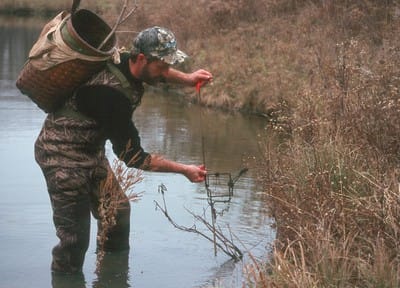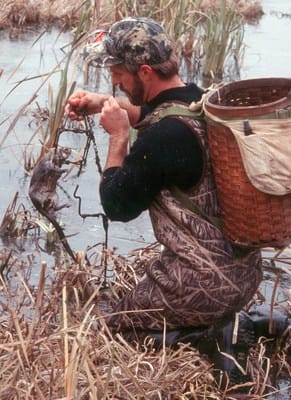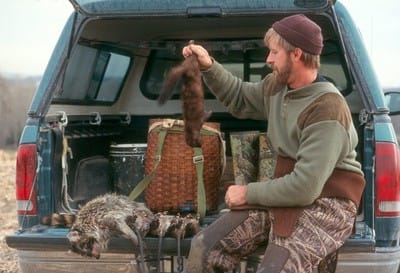
They, whoever they are, say that you can’t go home. Well, sir, that’s not entirely fact. True, life in your Midwestern hometown of 300 souls has probably changed quite a bit in the past 30 years, now hasn’t it? But ask a trapper about going home, just ask him. Can you, sir, do it again? Can you pick up where you left off? Will the enthusiasm and the excitement, the Every Day is Christmas Day feeling you have when you walk out the door in the morning. Will it still be there? Take it from me, it will, and it is. A trapper can go home; he can return to the trapline. How do I know? I’ll tell you a story.
A Spark Ignites
The date was Sunday, November 2, 2008, and I’m sitting in a small public marsh not far from our home in eastern Iowa. I’m hunting ducks, or at least I’m surrounded by plastic ducks, am in the company of a black lab dog, and possessed duck calls. Unfortunately, the birds didn’t get the invitation to the party. What I did see, though, were dozens upon dozens of muskrats houses and, surprisingly enough, not a single sign of a trapper. Furbearer season had opened the day before, and I had assumed the swamp to be ringed with steel. I was wrong.
“You know,” I told my wife, Julia Carol, that evening as I unpacked my duck gear. “There’s no one trapping the marsh. I’m going to get a tag, get my stuff ready, and run a short line. Might be fun.”
She gave me a sideways glance. I’d just been diagnosed with an inguinal hernia that needed repaired, and I awaited the “Do you really need to be doing that?” comment. “Be careful,” she said in blessing, “and take your phone. I want to know where to come and drag you out of the mud.” And with that, I had returned.

Monday, November 2, 2008
I spent the day purchasing a trapping tag, gathering gear, and inspecting traps for performance and the requisite name/address markers. With everything, including a small duck skiff I planned to use as a floating work station, ready and in my grandpa’s truck, I plotted and schemed my assault.
Tuesday, November 4, 2008
I arrive shortly after daybreak, slip the boat into the cold, black water, and set off. Within 60 minutes, I’m remembering what it was that was so taxing about running a trapline. It’s hard work! In and out of the skiff, pushing it through the cattails from muskrat house to muskrat house, there’s no sense in trying to stay dry. Within the first five minutes I’ve gone overtop my neoprene gauntlets not one, but twice, filling them to the top with chilly run-off water. But I’m enjoying myself, and, somewhat surprisingly, it’s all coming back to me. Number 110 conibears—body-grip traps—are positioned in runs and in/out holes around the edge of the houses. Active feed beds and slides get No. 1 jumps, stoploss, and No. 1.5 longsprings with the chains lengthened for extra weight. Each set is marked with a bright orange fiber-optic cable flag. Twenty years ago, I could remember where each and every set was. Today, I’m happy to find my wallet and my pants.
The night, as were nights long before, was spent wondering which traps would connect and which wouldn’t. I didn’t get much sleep; I didn’t figure I would.
Wednesday, November 5, 2008
I’m giggling as I push the skiff into the water. “Better than Christmas,” I tell the coot swimming out the channel. Some hit, some don’t, but when it’s all said and done, I have 17 beautiful ‘rats in the bottom of the boat.
Thursday, November 6, 2008
I add another 13 muskrats to the pile, but lose a coon that was held long enough to let him destroy one of my best ‘rat houses. Occupational hazard, I tell Julia Carol, as I unload and hang the day’s catch. That evening, a buddy comes over. We get the woodburner roaring, set the beer outside to stay cold, and skin and flat-freeze the 30 ‘rats. The shop smells like wet fur, swamp, hardwoods, and beer. It’s a good thing.

Friday, November 7, 2008
Prior to the weekend waterfowling onslaught—after all, it is a public marsh—I pull all my steel, putting another 25 big ‘rats in the boat. I’m a spectacle, a grown man in a shallow 10-foot plastic skiff surrounded by dozens of stakes, traps, milk crates, orange flags, and dead muskrats. As I paddle toward the ramp, I stop to talk to a pair of young fellows who have brought their sons out for the afternoon’s duck hunt. Before I leave, I give the boys my fleece hat and gauntlet gloves.The little ones mumble their Thank You, Sirs, and look at their dads quizzically. It’s a good day all around.
Epilogue
I sold my ‘rats on 15 November—55 beautifully-handled pelts netted me a total of $166.25. This equates to, when you factor out the three licenses and fuel costs, approximately $4.78 an hour wages. The four days in the swamp aggravated my hernia, which was subsequently repaired by surgery on November 19th. My hands are still cut up, I lost my wire cutters, and my little plastic boat might not ever be the same.
Would I do it all over again? Damn right I would, and as soon as this scar heals, you can bet I’ll be back out there walking the ice and snatching ‘rats. After all, I’m a trapper, it’s what I do.



